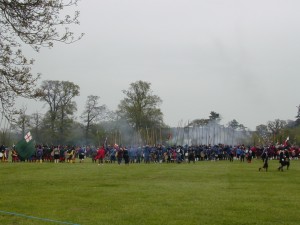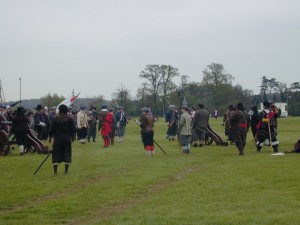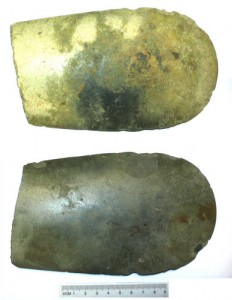Total posts:
187
05/16/2008






Between 3rd and 5th May 2008, Steve and colleagues visited the Sealed Knot ‘s 40th Birthday event, which they celebrated at Kelmarsh Hall, Northants with an enormous weekend of re-enactments centred around the Battle of Naseby, which took place nearby on 14th June 1645, and was a major turning point in the English Civil War.

The 2008 repeat of the Battle was a big success, and at the event Steve spoke to many interested adults and children about the PAS (partially helped by the fact that his stall was situated next to an armourer and an enormous late medieval suit of European plate armour). The Battlefields Trust and the Naseby Battlefield Project also had a presence there, so it was a good chance to spread the word about responsible detecting, and what it can tell us about the early postmedieval period, and miltary archaeology in particular. If you’re interested in this period, do have a look at the above links.

04/25/2008
It’s taken just over six months, but I have now just about looked at all the Roman coin records on the PAS database. Ive updated a few and added Reece periods to many and parish by parish, county by county begun to build up a picture of what’s happening nationwide (well England-wide to be precise).
Excitingly there are 469 parishes England-wide with more than 20 ‘Reeceable’ coins so I’ve got a lot of data to play with. Next step is to encourage detectorists to bring forward assemblages to their local FLOs, especially in some of the more patchy areas (Kent and County Durham being two) and to look for some good excavation coin assemblages.
Then it’s on to the analysis stage and the possibilities are endless…I’ll be looking to assess site function through coin profile (I’m particularly interested in rural shrines and temples) and to see whether I can make sense of some obvious regional patterning.
 ](files/2008/04/allplaces.jpg)
](files/2008/04/allplaces.jpg)
04/23/2008


This odd little copper alloy object is actually a late medieval macehead, dating to around the 14th century. It’s perhaps not obvious, being a bit smaller than the huge spikey-ball-shaped-things you see Brian Blessed and Mel Gibson smacking into people’s faces (in films, that is). Indeed, many of these items may have been used as the heads of staffs, rather than in warfare, and some may even have had an ecclesiastical association. Nonetheless, Derek Clarke, who found the find, knew instantly what it was.
Derek found the object on the Isle of Wight, while metal detecting on a trip away with his club (Northampton Detecting Association). The find’s context is particularly interesting; it was found not far from the medieval Carisbrooke Castle! Derek had just come out detecting after lunch, and was covering an area of the field that his fellow detectorists had left well alone, on account of a fairly steep slope. Nonetheless, several of his colleagues had already gone over the spot where the macehead was found, without getting a signal they thought worth investigating. Derek is understandably proud of his find, as he says ‘the Gods were on my side, that day!’.


The find, and its place in the local landscape, provide a good example of how individual finds can tell us about past activity in an area. The findspot data will be reported to the local Sites and Monuments Record, helping them better understand the development of the medieval landscape around the castle.
Well done Derek!
04/11/2008
The Somerset County Museum will close to the public on Saturday 19th April at 5pm for a Heritage Lottery Funded restoration and refurbishment.
Naomi Payne, Finds Liaison Officer for Somerset, will still be able to take in and return finds for identification and recording at the Museum on weekdays until August 2008. It is advisable to phone ahead to make sure she will be in the office when you wish to visit. Naomi’s direct dial telephone number is 01823 320206 and the Museum office telephone number is 01823 320200.
Naomi will be moving to the Record Office in Obridge Road, Taunton, in August 2008 and will be based there until new purpose built offices at Silk Mills are opened.
The Museum is due to reopen as the Museum of Somerset in August 2010.
03/21/2008




 ]
]
Until relatively recently, little was known of early prehistoric Northamptonshire. Over the last 30 years or so, fairly extensive excavation and landscape survey has allowed us to build some idea of Stone Age activity and settlement in the region, though there are still gaps in our knowledge. Finds of individual objects, and scatters of flint tools and waste, have the potential to add considerably to our knowledge, and objects recorded by the PAS thus have an important role to play. Here, I’ll just introduce some of the more interesting finds.

 Our only find certain to be from the Palaeolithic is the handaxe-like tool from Gayton [NARC-FD1537], previously noted in this blog. But it’s a lovely find, so I thought you might want to see it again. We have had other possible items of Palaeolithic date, including cores, but these are less certain.
Our only find certain to be from the Palaeolithic is the handaxe-like tool from Gayton [NARC-FD1537], previously noted in this blog. But it’s a lovely find, so I thought you might want to see it again. We have had other possible items of Palaeolithic date, including cores, but these are less certain.
From the Mesolithic, with 33 records at the time of writing, we have a little more to go on, though I think it’s fair to say that the finds from this period don’t tend to the spectacular (sorry Nicky!). PAS finds from Northants include Mesolithic microliths and waste scatters from the Gayton, Towcester and Elkington areas, which may well indicate toolmaking activity at the site. Such finds are perhaps not aesthetically striking in their own right, but are nonetheless valuable to the archaeologist in what they can tell us about how people moved through and used the Mesolithic landcsape of Northamptonshire.


For the Neolithic, with 127 records, we have a greater range of material, including a number of Early and Late Neolithic flint scrapers and waste from Towcester and Brackley in the west to Rushden and Oundle in the east. Particularly nice examples include a bifacial leaf-shaped arrowhead from the Moulton area [NARC-A76CD1] as well as polished axes, such as this example from near Hinton-in-the-Hedges [NARC-B52DA6], and this greenstone adze from close to the Bucks border **. Such tools as this last were made by specialists in areas such as the Lake District and Cornwall, and traded over great distances.
Other objects of probable early prehistoric date include bone beads [NARC-248CB1] and the above Neolithic antler macehead [NARC-181793]. Such objects were probably the templates for late Neolithic stone maces and hammers, but examples are few, so this is an important example.
All in all, finds from ‘pre-metallic’ Northamptonshire seem under-represented in comparison with those from later periods. This is unsurprising, but one hopes that the situation will improve as detectorists and fieldwalkers become more aware of the importance of such material, and become better at identifying it. Nonetheless, the ability to identify flint scatters on maps is useful in telling us about settlements, temporary camps, and itinerant activity throughout this time period, while the more exotic finds (such as Langdale and other greenstone axes) are testament to long distance axes of trade working through the county and beyond.
03/21/2008
Northants Review Part I: The Early Prehistoric Period






Until relatively recently, little was known of early prehistoric Northamptonshire. Over the last 30 years or so, fairly extensive excavation and landscape survey has allowed us to build some idea of Stone Age activity and settlement in the region, though there are still gaps in our knowledge. Finds of individual objects, and scatters of flint tools and waste, have the potential to add considerably to our knowledge, and objects recorded by the PAS thus have an important role to play. Here, I’ll just introduce some of the more interesting finds.


Our only find certain to be from the Palaeolithic is the handaxe-like tool from Gayton (NARC-FD1537), previously noted in this blog. But it’s a lovely find, so I thought you might want to see it again. We have had other possible items of Palaeolithic date, including cores, but these are less certain.
From the Mesolithic, with 33 records at the time of writing, we have a little more to go on, though I think it’s fair to say that the finds from this period don’t tend to the spectacular (sorry Nicky!). PAS finds from Northants include Mesolithic microliths and waste scatters from the Gayton, Towcester and Elkington areas, which may well indicate toolmaking activity at the site. Such finds are perhaps not aesthetically striking in their own right, but are nonetheless valuable to the archaeologist in what they can tell us about how people moved through and used the Mesolithic landcsape of Northamptonshire.

For the Neolithic, with 127 records, we have a greater range of material, including a number of Early and Late Neolithic flint scrapers and waste from Towcester and Brackley in the west to Rushden and Oundle in the east. Particularly nice examples include a bifacial leaf-shaped arrowhead from the Moulton area (NARC-A76CD1) as well as polished axes, such as this example from near Hinton-in-the-Hedges (NARC-B52DA6), and this greenstone adze from close to the Bucks border (NARC-180DE7) . Such tools as this last were made by specialists in areas such as the Lake District and Cornwall, and traded over great distances.
Other objects of probable early prehistoric date include bone beads (NARC-248CB1) and the above Neolithic antler macehead (NARC-181793). Such objects were probably the templates for late Neolithic stone maces and hammers, but examples are few, so this is an important example.
All in all, finds from ‘pre-metallic’ Northamptonshire seem under-represented in comparison with those from later periods. This is unsurprising, but one hopes that the situation will improve as detectorists and fieldwalkers become more aware of the importance of such material, and become better at identifying it. Nonetheless, the ability to identify flint scatters on maps is useful in telling us about settlements, temporary camps, and itinerant activity throughout this time period, while the more exotic finds (such as Langdale and other greenstone axes) are testament to long distance axes of trade working through the county and beyond.



 ](files/2008/04/allplaces.jpg)
](files/2008/04/allplaces.jpg)





 ]
] Our only find certain to be from the Palaeolithic is the handaxe-like tool from Gayton [NARC-FD1537], previously noted in this blog. But it’s a lovely find, so I thought you might want to see it again. We have had other possible items of Palaeolithic date, including cores, but these are less certain.
Our only find certain to be from the Palaeolithic is the handaxe-like tool from Gayton [NARC-FD1537], previously noted in this blog. But it’s a lovely find, so I thought you might want to see it again. We have had other possible items of Palaeolithic date, including cores, but these are less certain.
